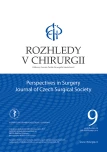Use of preperitoneal wound catheter for continuous local anaesthesia after laparoscopic colorectal surgery
Authors:
V. Procházka 1; M. Svoboda 2; R. Svatoň 1; T. Grolich 1; M. Farkašová 1; Z. Kala 1
Authors‘ workplace:
Chirurgická klinika lékařské fakulty Masarykovy univerzity – Fakultní nemocnice Brno
1; Lékařská fakulta Masarykovy univerzity
2
Published in:
Rozhl. Chir., 2019, roč. 98, č. 9, s. 356-361.
Category:
Original articles
doi:
https://doi.org/10.33699/PIS.2019.98.9.356–361
Overview
Introduction: The main cause of postoperative pain after abdominal surgery is the wound where laparotomy is made. Recently, laparoscopic procedures have become common in colorectal surgery. Although improving the tolerance of the surgery, postoperative pain management still remains a discussed problem. The use of an epidural catheter used to be generally recommended in the open surgery era; however, an ideal strategy for postoperative analgesic therapy after laparoscopy remains unclear. Reduced administration of opioid analgesic drugs after colorectal resection is a generally accepted goal. Preperitoneal catheter insertion for continuous local anaesthetic (LA) infusion in the wound after surgery is a simple alternative to other pain management methods.
Methods: Retrospective analysis of analgotherapy outcomes in patients undergoing laparoscopic colorectal resection procedures, divided in three patient groups according to the type of analgesia: Group 1: use of a catheter for local wound infusion (KAT) n=73; group 2: epidural analgesia (EPI) n=23; and control group 3 with combined parenteral and subcutaneous analgesia (CON) n=66. The main objective of this study was to analyse postoperative pain and the consumption of opioid analgesics in the first three days from the surgery and the incidence of any complications related to the analgesic therapy.
Results: Opioid consumption in KAT and EPI groups was significantly lower compared to CON in the first 72 hours from the surgery. The lowest postoperative pain was measured in the EPI group. Subjective perception of pain, measured using VAS, was not significantly different between the KAT and CON groups. In KAT patients, vomiting was statistically less frequent than in CON patients. There was no significantly different incidence of paralytic ileus in the KAT and CON groups and no paralytic ileus was observed in the EPI group. There was no increased incidence of SSI (surgical site infections) in the KAT group compared to the other groups.
Conclusion: The use of the catheter was assessed as safe. Insertion and management of the catheter is unsophisticated, and we did not observe any complications in terms of application of the catheter or toxic side effects of the LA. The use of the catheter clearly reduced opioid administration in the postoperative period compared to the control group (CON) with combined parenteral and subcutaneous analgesics. The best pain control measured using the visual analog scale (VAS) was observed in the EPI group.
Keywords:
wound catheter – colorectal surgery – opioid analgesics – postoperative pain
Sources
- Rawal N. Treating postoperative pain improves outcome. Minerva anestesiologica 2001;67:200−5.
- Kocian P, Přikryl P, Bočková M, et al. ERAS v kolorektální chirurgii u geriatrických pacientů. Rozhl Chir. 2018;97:27−33.
- Kasalický M, Martínek L, Penka I. Je laparoskopická kolorektální chirurgie bezpečná i u starších pacientů? Rozhl Chir. 2018;97:21–6.
- Freise H, Van Aken HK. Risks and benefits of thoracic epidural anaesthesia. British Journal of Anaesthesia 2011;107:859−68. doi:10.1093/bja/aer339.
- Borzellino G, Francis NK, Chapuis O, et al. Role of epidural analgesia within an ERAS program after laparoscopic colorectal surgery: A review and meta-analysis of randomised controlled studies. Surg Res Pract. 2016;7543684. doi:10.1155/2016/7543684.
- Pierra B, Alagna V, Lucchi A, et al. Transversus abdominis plane (TAP) block versus thoracic epidural analgesia (TEA) in laparoscopic colon surgery in the ERAS program. Surg Endosc. 2018;32:376−82. doi:10.1007/s00464-017-5686-7.
- Bertoglio S, Fabiani F, Negri PD, et al. The postoperative analgesic efficacy of preperitoneal continuous wound infusion compared to epidural continuous infusion with local anesthetics after colorectal cancer surgery: a randomized controlled multicenter study. Anesth Analg. 2012;115:1442−50. doi:10.1213/ANE.0b013e31826b4694.
- Škrovina M, Straka M, Holášková E, et al. Karcinom tlustého střeva – zhodnocení komplikací a rizik plánovaných resekčních výkonů. Rozhl Chir. 2014;93:311−6.
- Hermanides J, Hollman MW, Stevens MF, et al. Failed epidural causes and management. British Journal of Anaesthesia 2012;109:144−54. doi:10.1093/bja/aes214.
- Wong-Lun-Hing EM, van Dam RM, Welsh FK, et al. Postoperative pain control using continuous i.m. bupivacaine infusion plus patient-controlled analgesia compared with epidural analgesia after major hepatectomy. HPB (Oxford) 2014;16:601–9. doi:10.1111/hpb.12183.
- Howard DP, Datta G, Cunnick G, et al. Surgical site infection rate is lower in laparoscopic than open colorectal surgery. Colorectal Disease 2010;12:423−7. doi:10.1111/j.1463-1318.2009.01817.x.
- Claroni C, Marcelli ME, Sofra MC, et al. Preperitoneal continuous infusion of local anesthetics: What is the impact on surgical wound infections in humans? Pain Med. 2016;17:582−9.
- Boulind CE, Ewings P, Bulley SH, et al. Feasibility study of analgesia via epidural versus continuous wound infusion after laparoscopic colorectal resection. Br J Surg. 2013;100:395−402. doi:10.1002/bjs.8999.
- Hebbard PD, Barrington MJ, Vasey C. Ultrasound-guided continuous oblique subcostal transversus abdominis plane blockade: description of anatomy and clinical technique. Reg Anesth Pain Med. 2010;35:436−41.
- Zhang D, Zhou C, Wei D, et al. Dexamethasone added to local anesthetics in ultrasound-guided transversus abdominis plain (TAP) block for analgesia after abdominal surgery: A systematic review and meta-analysis of randomized controlled trials. PLoS One 2019;14:e0209646. doi:10.1371/journal.pone.0209646.
Labels
Surgery Orthopaedics Trauma surgeryArticle was published in
Perspectives in Surgery

2019 Issue 9
Most read in this issue
- Foreign body ingestion in children
- Phyllodes tumours – a retrospective review of 83 clinical cases
- ERAS in colorectal surgery – neglected preadmission items
- Percutaneous endoscopic cecostomy in the treatment of recurrent colonic pseudo-obstruction − a case report of the first procedure in the Czech Republic
